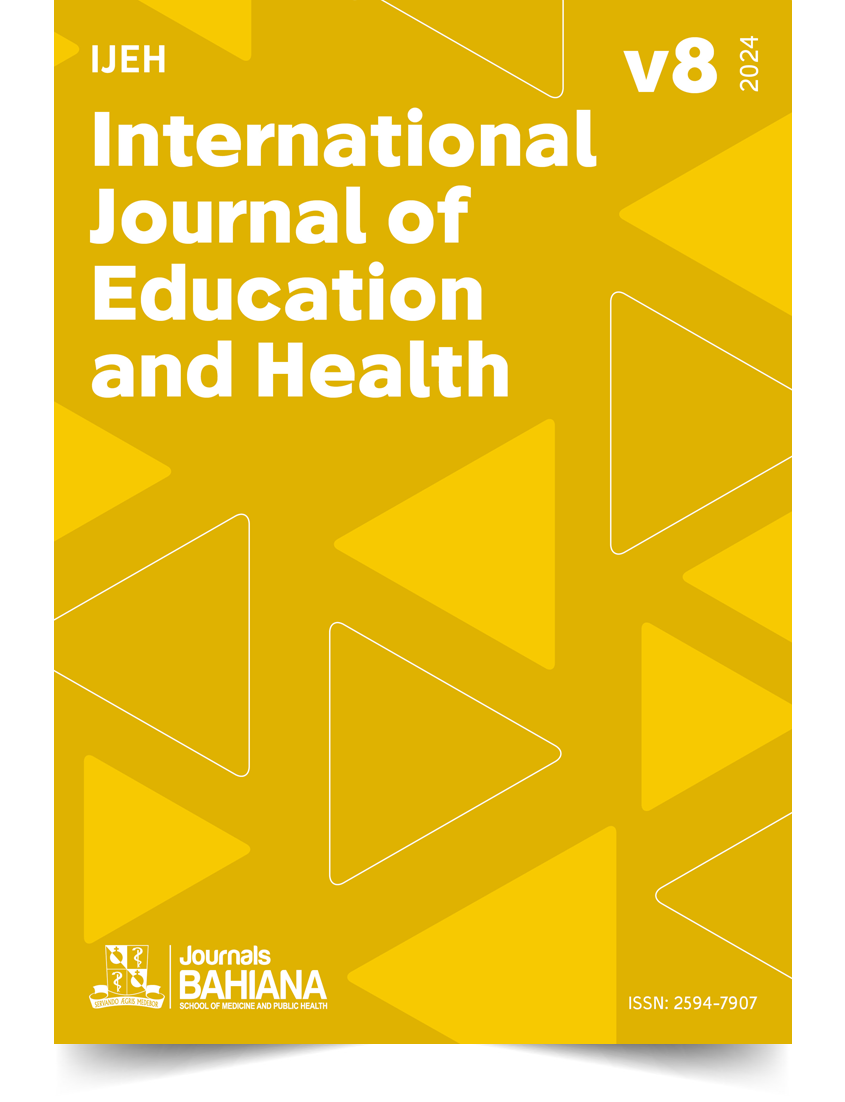Insertion and performance of the resident physiotherapist in an obstetric center: experience report
DOI:
https://doi.org/10.17267/2594-7907ijeh.2024.e5766Keywords:
Physical Therapy Modalities, Labor, Obstetric, Delivery RoomsAbstract
INTRODUCTION: The obstetric center (OC) is a sector designed to welcome pregnant women in labor to undergo natural childbirth or cesarean section. Physiotherapeutic intervention helps the woman in labor to deal with the changes that occur in the body during childbirth, using non-pharmacological techniques and resources to alleviate pain, as well as suggesting childbirth postures. OBJECTIVE: This study aimed to report on the insertion and performance of a physiotherapist resident in OC. MATERIAL AND METHODS: This is an experience report from a physiotherapist resident of the Multiprofessional Residency Program in Hospital Health, in the OC sector. It was carried out between September and October 2023, at the HGRS maternity ward, in the city of Salvador - Bahia. RESULTS: The resident physiotherapist was added to the multidisciplinary team, working under the supervision of the physiotherapist/preceptor, scheduled on the day of the shift. During labor, non-pharmacological measures were offered to alleviate pain and pelvic mobility exercises were suggested, as well as childbirth postures. In the immediate childbirth period, many parturient women reported how important it was to have a physiotherapist at this point in their lives, making comparisons with previous childbirths in which they did not have this type of assistance. FINAL CONSIDERATIONS: The resident physiotherapist had complete autonomy to suggest actions to parturient women, combining theory and practice, resulting in effective labor childbirth, contributing to the quality of the service provided. This experience also contributed to professional growth and awakening to a field of physiotherapy that is still little explored.
Downloads
References
(1) Ministério da Saúde (Brazil). Resolução nº 36, de 3 de junho de 2008. Dispõe sobre regulamento técnico para funcionamento dos serviços de atenção obstétrica e neonatal. [Internet]. Diário Oficial da União. 2008 jun. 3. Available from: https://bvsms.saude.gov.br/bvs/saudelegis/gm/2010/prt2472_31_08_2010.html
(2) FIOCRUZ. Instituto Nacional de Saúde da Mulher, da Criança e do Adolescente Fernandes Figueira. Portal de Boas Práticas em Saúde da Mulher, da Criança e do Adolescente. Principais questões sobre segundo período do trabalho de parto. Rio de Janeiro: FIOCRUZ; 2018. Available from: https://portaldeboaspraticas.iff.fiocruz.br/atencao-mulher/principais-questoes-sobre-segundo-periodo-do-trabalho-de-parto/
(3) Fabricio AMF, Ferreira CHJ, Dias LAR, Mascarenhas LR, Oliveira NFF. "Por Mais Fisioterapeutas nas Maternidades": conquistas da Campanha ABRAFISM. Belém, PA: Associação Brasileira de Fisioterapia na Saúde da Mulher, 2023. Available from: https://abrafism.org.br/ebookcampanhamaternidades
(4) Ministério da Saúde (Brazil), Secretaria de Ciência, Tecnologia e Insumos Estratégicos. Departamento de Gestão e Incorporação de Tecnologias em Saúde. Diretrizes nacionais de assistência ao parto normal: versão resumida [Internet]. Brasília: Ministério da Saúde; 2017. Available from: http://bvsms.saude.gov.br/bvs/publicacoes/diretrizes_nacionais_assistencia_parto_normal.pdf
(5) Ministério da Saúde (Brazil), Secretaria de Ciência, Tecnologia e Insumos Estratégicos. Departamento de Gestão e Incorporação de Tecnologias em Saúde. Diretrizes nacionais de assistência ao parto normal: versão preliminar [Internet]. Brasília: Ministério da Saúde; 2022. Available from: https://www.google.com/url?sa=t&source=web&rct=j&opi=89978449&url=https://www.febrasgo.org.br/pt/noticias/item/download/615_9c68b60515aeb7bb1f3f022505721f2b&ved=2ahUKEwifjvC84MyIAxXHspUCHZqUJSMQFnoECBQQAQ&usg=AOvVaw0foNbPUUB7E5b6rK_19mfE
(6) Febrasgo. Assistência aos quatro períodos do parto de risco habitual. Protocolos Febrasgo. 2018;101. Available from: https://www.febrasgo.org.br/images/pec/Protocolos-assistenciais/Protocolos-assistenciais-obstetricia.pdf/n101---O---Assistencia-aos-quatro-periodos-do-parto-de-risco-habitual.pdf
(7) Gupta JK, Sood A, Hofmeyr GJ, Vogel JP. Position in the second stage of labour for women without epidural anaesthesia. Cochrane Database Syst Rev. 2017;5:CD002006. https://doi.org/10.1002/14651858.CD002006.pub4
(8) Gupta N, Deierl A, Hills E, Banerjee J. Systematic review confirmed the benefits of early skin-to-skin contact but highlighted lack of studies on very and extremely preterm infants. Acta Paediatr. 2021;110(8):2310-5. https://doi.org/10.1111/apa.15913.
(9) Conselho Federal de Fisioterapia e Terapia Ocupacional (Coffito). Resolução nº 372, de 6 de novembro de 2009. Reconhece a Saúde da Mulher como especialidade do profissional Fisioterapeuta e dá outras providências. [Internet]. Diário Oficial da União. 2009 nov. 30. Available from: https://www.coffito.gov.br/nsite/?p=3135
(10) Bio ER, Bittar RE, Zugaib M. Influência da mobilidade materna na duração da fase ativa do trabalho de parto. Rev Bras Ginecol Obstet. 2006;28(11):671-9. https://doi.org/10.1590/S0100-72032006001100007
(11) Costa MES, Matias MKP, Pereira MM, Caldas GRF. The benefits of Physiotherapy in Childbirth and Puerperium. RSD. 2022;11(3):e53011326740. https://doi.org/10.33448/rsd-v11i3.26740
(12) Bio ER. Intervenção fisioterapêutica na assistência ao trabalho de parto [dissertation] [Internet]. São Paulo: Universidade de São Paulo; 2007. Available from: https://www.teses.usp.br/teses/disponiveis/5/5139/tde-12022008-141747/publico/ElianeRodriguesBio.pdf
(13) Dias EG, Ferreira ARM, Martins AMC, Jesus MM, Alves JCS. Efficacy of non-pharmacological methods for pain relief in labor normal of parturition. Enferm Foco. 2018;9(2):35-9. Available from: http://revista.cofen.gov.br/index.php/enfermagem/article/view/1398/442
(14) Gallo RBS, Santana LS, Marcolin AC, Duarte G, Quintana SM. Sequential application of non-pharmacological interventions reduces the severity of labour pain, delays use of pharmacological analgesia, and improves some obstetric outcomes: a randomised trial. J. physiother. 2018;64(1):33-40. https://doi.org/10.1016/j.jphys.2017.11.014
(15) Borba EO, Amarante MV, Lisboa DDJ. Physiotherapeutic assistance during labor. Fisioter Pesqui. 2021;28(3):324-30. https://doi.org/10.1590/1809-2950/2100062803202
Downloads
Published
Issue
Section
License
Copyright (c) 2024 Fernanda Lopes Alves Santos, Débora Sales de Castro

This work is licensed under a Creative Commons Attribution 4.0 International License.
This work is licensed under a Creative Commons Attribution 4.0 International License.



